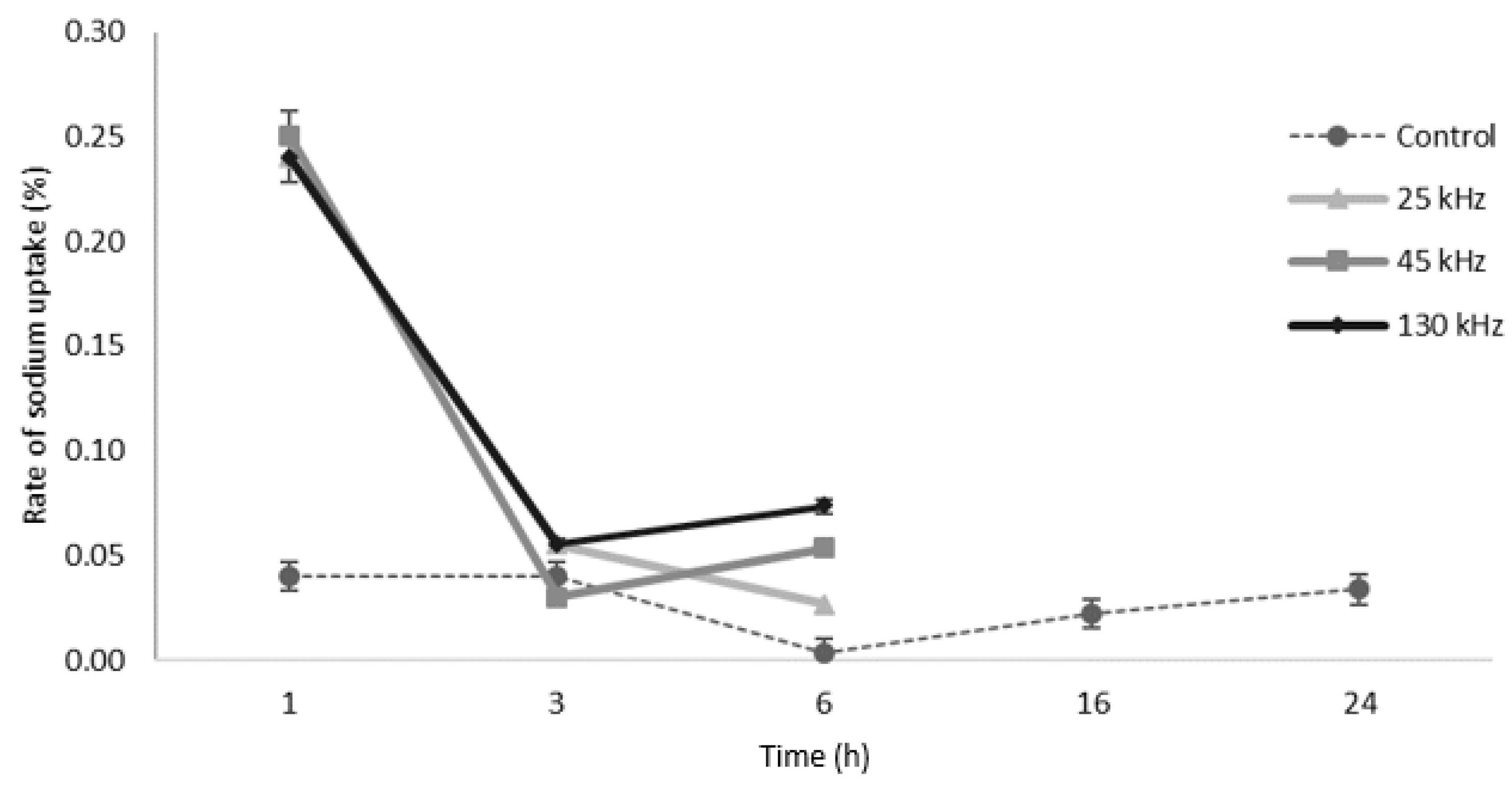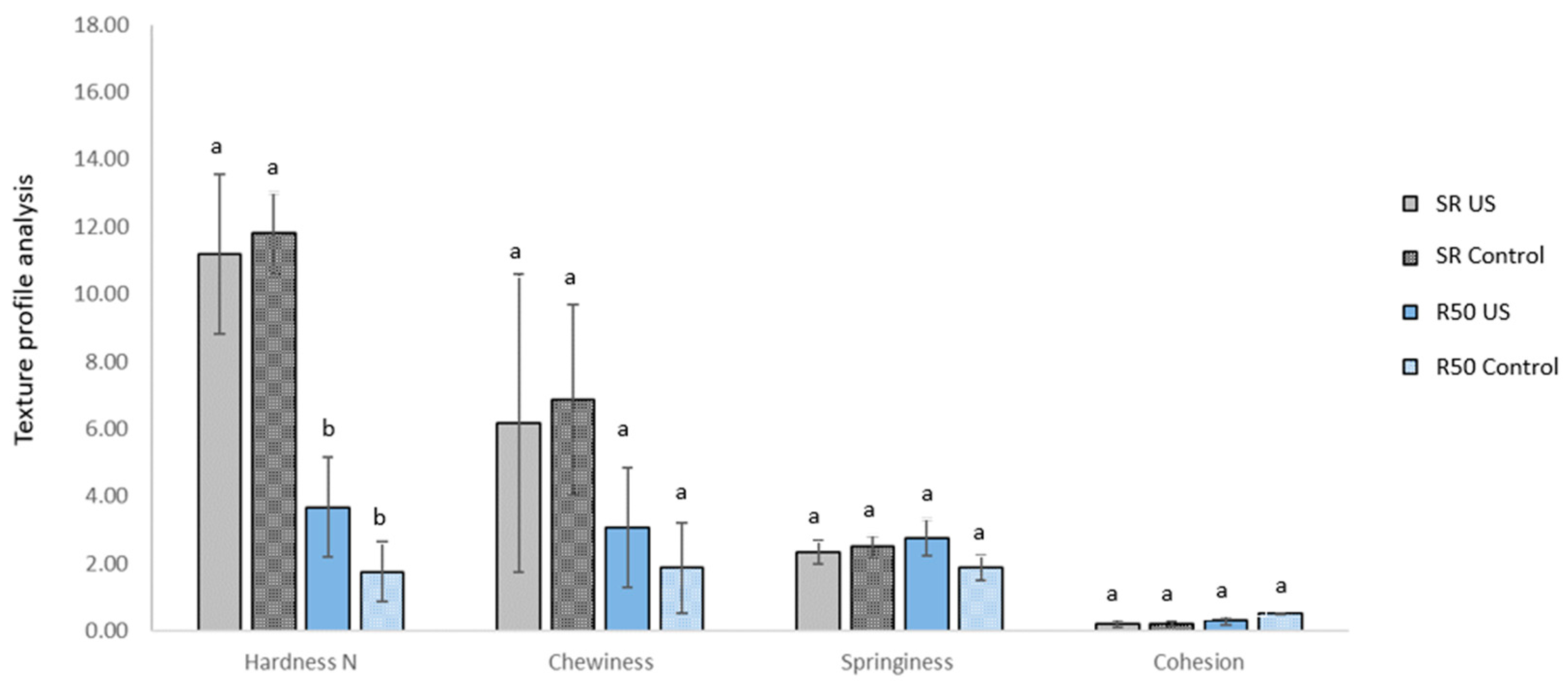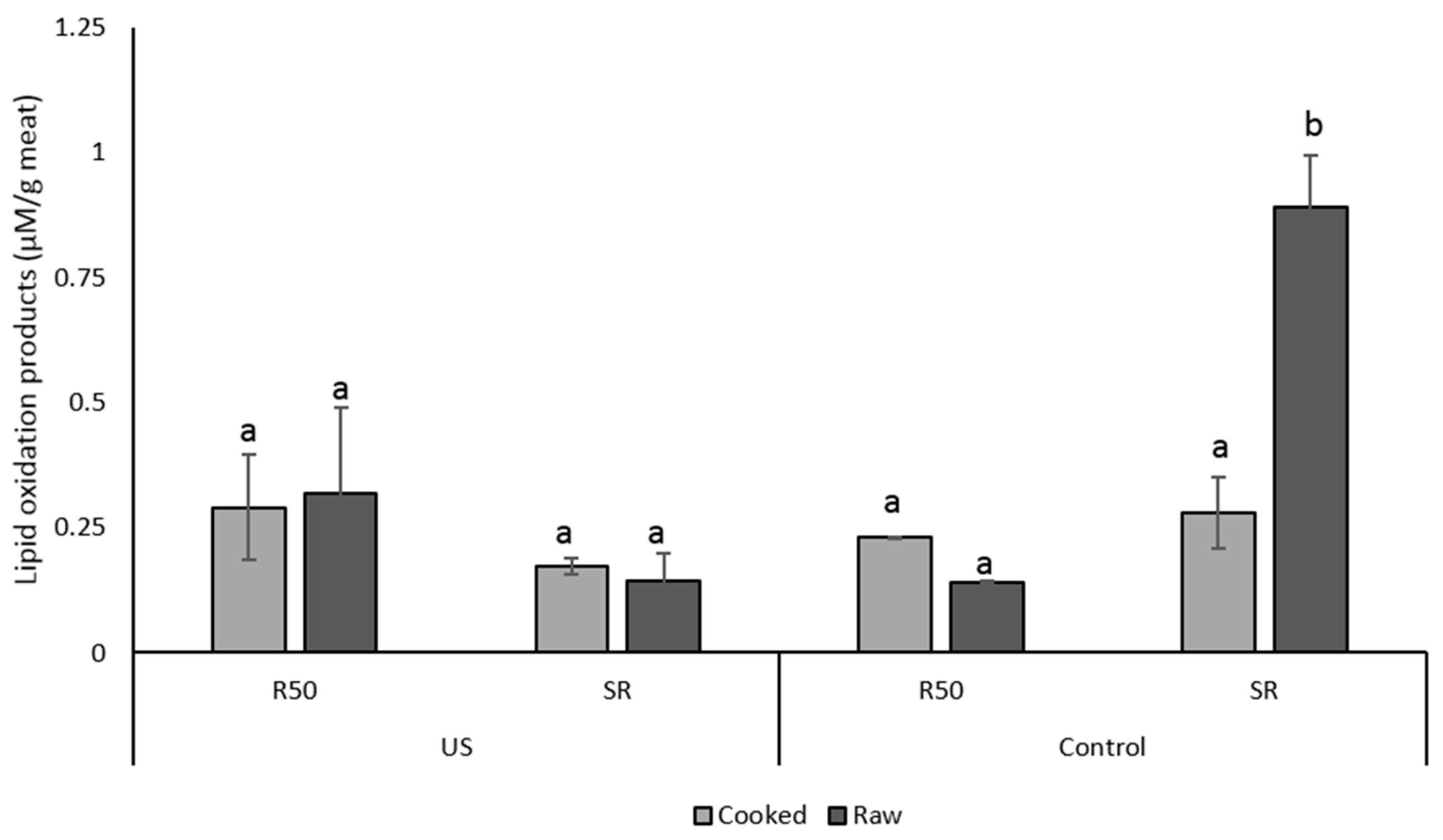Ultrasound-Assisted Marination: Role of Frequencies and Treatment Time on the Quality of Sodium-Reduced Poultry Meat
Abstract
1. Introduction
2. Materials and Methods
2.1. Sample and Marinade Preparation
2.2. Ultrasound Treatment
2.3. Sodium Content
2.4. Cooking Method and Cook Loss
2.5. Formation of Secondary Lipid oxidation Products
2.6. Texture Profile Analysis (TPA)
2.7. Statistical Analysis
3. Results and Discussion
3.1. Effects of Ultrasonic Frequencies on Sodium Uptake
3.2. Texture Profile Analysis
3.3. Formation of Secondary Lipid Oxidation Products
3.4. Quality Parameters of Reduced-Salt Marinated Chicken
4. Conclusions
Author Contributions
Funding
Acknowledgments
Conflicts of Interest
References
- Smith, D.P.; Acton, J.C. Marination, Cooking, and Curing of Poultry Products; CRC Press: Boca Raton, FL, USA, 2010. [Google Scholar]
- Yusop, S.; O’Sullivan, M.G.; Kerry, J.F.; Kerry, J.P. Sensory Evaluation of Chinese-Style Marinated Chicken by Chinese and European Naïve Assessors. J. Sens. Stud. 2009, 24, 512–533. [Google Scholar] [CrossRef]
- Yusop, S.; O’Sullivan, M.G.; Kerry, J.F.; Kerry, J.P. Sensory Evaluation of Indian-Style Marinated Chicken by Malaysian and European Naïve Assessors. J. Sens. Stud. 2009, 24, 269–289. [Google Scholar] [CrossRef]
- Yusop, S.M.; O’Sullivan, M.G.; Kerry, J.P. Marinating and Enhancement of the Nutritional Content of Processed Meat Products Processed Meats; Woodhead Publishing: Cambridge, UK, 2011; Volume 17, pp. 421–449. [Google Scholar]
- Babji, A.S.; Froning, G.W.; Ngoka, D.A. The Effect of Short-Term Tumbling and Salting on the Quality of Turkey Breast Muscle. Poult. Sci. 1982, 61, 300–303. [Google Scholar] [CrossRef]
- Collins, J.E. Reducing salt (sodium) levels in processed meat, poultry and fish products. In Production and Processing of Healthy Meat, Poultry and Fish Products; Pearson, A.M., Dutson, T.R., Eds.; Springer: New York, NY, USA, 1997; pp. 282–297. [Google Scholar]
- Froning, G.W.; Sackett, B. Effect of Salt and Phosphates during Tumbling of Turkey Breast Muscle on Meat Characteristics. Poult. Sci. 1985, 64, 1328–1333. [Google Scholar] [CrossRef]
- Alarcon-Rojo, A.; Janacua, H.; Rodríguez, J.; Paniwnyk, L.; Mason, T.J. Power ultrasound in meat processing. Meat Sci. 2015, 107, 86–93. [Google Scholar] [CrossRef]
- Carcel, J.A.; Benedito, J.; Bon, J.; Mulet, A. High intensity ultrasound effects on meat brining. Meat Sci. 2007, 76, 611–619. [Google Scholar] [CrossRef]
- González-González, L.; Luna-Rodríguez, L.; Carrillo-López, L.M.; Alarcón-Rojo, A.D.; García-Galicia, I.; Reyes-Villagrana, R. Ultrasound as an Alternative to Conventional Marination: Acceptability and Mass Transfer. J. Food Qual. 2017, 2017, 1–8. [Google Scholar] [CrossRef]
- Inguglia, E.S.; Zhang, Z.; Burgess, C.; Kerry, J.P.; Tiwari, B.K. Influence of extrinsic operational parameters on salt diffusion during ultrasound assisted meat curing. Ultrasonics 2018, 83, 164–170. [Google Scholar] [CrossRef]
- Inguglia, E.S.; Zhang, Z.; Tiwari, B.K.; Kerry, J.P.; Burgess, C.M. Salt reduction strategies in processed meat products—A review. Trends Food Sci. Technol. 2017, 59, 70–78. [Google Scholar] [CrossRef]
- Ojha, K.S.; Keenan, D.F.; Bright, A.; Kerry, J.P.; Tiwari, B.K. Ultrasound assisted diffusion of sodium salt replacer and effect on physicochemical properties of pork meat. Int. J. Food Sci. Technol. 2016, 51, 37–45. [Google Scholar] [CrossRef]
- Troy, D.J.; Ojha, K.S.; Kerry, J.P.; Tiwari, B.K. Sustainable and consumer-friendly emerging technologies for application within the meat industry: An overview. Meat Sci. 2016, 120, 2–9. [Google Scholar] [CrossRef] [PubMed]
- Tan, S.; De Kock, H.; Dykes, G.; Coorey, R.; Buys, E. Enhancement of poultry meat: Trends, nutritional profile, legislation and challenges. S. Afr. J. Anim. Sci. 2018, 48, 199–212. [Google Scholar] [CrossRef]
- Tiwari, B.K.; Muthukumarappan, K.; O’Donnell, C.P.; Cullen, P.J.; Tiwari, B. Effects of Sonication on the Kinetics of Orange Juice Quality Parameters. J. Agric. Food Chem. 2008, 56, 2423–2428. [Google Scholar] [CrossRef] [PubMed]
- Baugreet, S.; Kerry, J.P.; Botineştean, C.; Allen, P.; Hamill, R.M. Development of novel fortified beef patties with added functional protein ingredients for the elderly. Meat Sci. 2016, 122, 40–47. [Google Scholar] [CrossRef] [PubMed]
- Botsoglou, N.A.; Fletouris, D.J.; Papageorgiou, G.E.; Vassilopoulos, V.N.; Mantis, A.J.; Trakatellis, A.G. Rapid, Sensitive, and Specific Thiobarbituric Acid Method for Measuring Lipid Peroxidation in Animal Tissue, Food, and Feedstuff Samples. J. Agric. Food Chem. 1994, 42, 1931–1937. [Google Scholar] [CrossRef]
- Leal-Ramos, M.Y.; Alarcon-Rojo, A.D.; Mason, T.J.; Paniwnyk, L.; Alarjah, M. Ultrasound-enhanced mass transfer in Halal compared with non-Halal chicken. J. Sci. Food Agric. 2011, 91, 130–133. [Google Scholar] [CrossRef] [PubMed]
- Bermudez-Aguirre, D. Chapter 5—Sonochemistry of Foods. In Ultrasound: Advances for Food Processing and Preservation; Bermudez-Aguirre, D., Ed.; Academic Press: San Diego, CA, USA, 2017; pp. 131–143. [Google Scholar]
- Chang, H.-J.; Wang, Q.; Tang, C.-H.; Zhou, G.-H. Effects of Ultrasound Treatment on Connective Tissue Collagen and Meat Quality of Beef Semitendinosus Muscle. J. Food Qual. 2015, 38, 256–267. [Google Scholar] [CrossRef]
- Jayasooriya, S.; Torley, P.; D’Arcy, B.; Bhandari, B.; Torley, P.; Bhandari, B. Effect of high power ultrasound and ageing on the physical properties of bovine Semitendinosus and Longissimus muscles. Meat Sci. 2007, 75, 628–639. [Google Scholar] [CrossRef] [PubMed]
- Li, K.; Kang, Z.-L.; Zou, Y.-F.; Xu, X.-L.; Zhou, G.-H. Effect of ultrasound treatment on functional properties of reduced-salt chicken breast meat batter. J. Food Sci. Technol. 2015, 52, 2622–2633. [Google Scholar] [CrossRef]
- Naeli, M.H.; Kenari, E.R. Effect of ultrasound bath and probe combined to brine and brine polyphosphate solutions on the qualitative and textural properties of beef meat. Iran. Food Sci. Technol. Res. J. 2017, 13, 117–130. [Google Scholar]
- Caine, W.; Aalhus, J.; Best, D.; Dugan, M.; Jeremiah, L. Relationship of texture profile analysis and Warner-Bratzler shear force with sensory characteristics of beef rib steaks. Meat Sci. 2003, 64, 333–339. [Google Scholar] [CrossRef]
- de Huidobro, F.R.; Martínez, V.C.; Gómez, S.L.; Velasco, S.; Pérez, C.; Onega, E. Sensory Characterization of Meat Texture in Sucking Lamb: Methodology. Invest. Agrar. Prod. Sanid. Anim. 2001, 16, 223–234. [Google Scholar]
- Jambrak, A.R.; Herceg, Z. Application of Ultrasonics in Food Preservation and Processing. In Conventional and Advanced Food Processing Technologies; Bhattacharya, S., Ed.; Wiley Online Library: Hoboken, NJ, USA, 2014; pp. 515–536. [Google Scholar]
- Siró, I.; Vén, C.; Balla, C.; Jonas, G.; Zeke, I.; Friedrich, L. Application of an ultrasonic assisted curing technique for improving the diffusion of sodium chloride in porcine meat. J. Food Eng. 2009, 91, 353–362. [Google Scholar] [CrossRef]
- Mariutti, L.R.; Bragagnolo, N. Influence of salt on lipid oxidation in meat and seafood products: A review. Food Res. Int. 2017, 94, 90–100. [Google Scholar] [CrossRef] [PubMed]
- Pérez-Andrés, J.M.; Charoux, C.M.G.; Cullen, P.J.; Tiwari, B.K.; Pérez, J. Chemical Modifications of Lipids and Proteins by Nonthermal Food Processing Technologies. J. Agric. Food Chem. 2018, 66, 5041–5054. [Google Scholar] [CrossRef] [PubMed]
- McDonnell, C.K.; Lyng, J.G.; Arimi, J.M.; Allen, P. The acceleration of pork curing by power ultrasound: A pilot-scale production. Innov. Food Sci. Emerg. Technol. 2014, 26, 191–198. [Google Scholar] [CrossRef]
- Dötsch, M.; Busch, J.; Batenburg, M.; Liem, G.; Tareilus, E.; Mueller, R.; Meijer, G. Strategies to Reduce Sodium Consumption: A Food Industry Perspective. Crit. Rev. Food Sci. Nutr. 2009, 49, 841–851. [Google Scholar] [CrossRef] [PubMed]
- Stanley, R.E.; Bower, C.G.; Sullivan, G.A. Influence of sodium chloride reduction and replacement with potassium chloride based salts on the sensory and physico-chemical characteristics of pork sausage patties. Meat Sci. 2017, 133, 36–42. [Google Scholar] [CrossRef]
- Regulation (EC) No 1924/2006 of the European Parliament and of the Council. Off. J. Eur. Union. 2006, OJ L12, 3–18.
- Soglia, F.P.; Petracci, M.; Mudalal, S.; Vannini, L.; Gozzi, G.; Camprini, L.; Cavani, C. Partial replacement of sodium chloride with potassium chloride in marinated rabbit meat. Int. J. Food Sci. Technol. 2014, 49, 2184–2191. [Google Scholar] [CrossRef]
- Hamm, R. Functional Properties of the Myofibrillar System and Their Measurements; Academic Press: San Diego, CA, USA, 1986; Volume 4, pp. 135–199. [Google Scholar]
- Gou, P.; Guerrero, L.; Gelabert, J.; Arnau, J. Potassium chloride, potassium lactate and glycine as sodium chloride substitutes in fermented sausages and in dry-cured pork loin. Meat Sci. 1996, 42, 37–48. [Google Scholar] [CrossRef]
- Frye, C.B.; Hand, L.W.; Calkins, C.R.; Mandigo, R.W. Reduction or Replacement of Sodium Chloride in a Tumbled Ham Product. J. Food Sci. 1986, 51, 836–837. [Google Scholar] [CrossRef]
- Desmond, E. Reducing salt: A challenge for the meat industry. Meat Sci. 2006, 74, 188–196. [Google Scholar] [CrossRef] [PubMed]



| Time | Frequency | CL | Na | Hd | Cw. | Sp. | Ch. | MDA-c | |
|---|---|---|---|---|---|---|---|---|---|
| Frequency | 0.399 ** | - | - | - | - | - | - | - | - |
| CL | 0.394 ** | 0.199 | - | - | - | - | - | - | - |
| Na | 0.531 ** | 0.286 ** | 0.085 | - | - | - | - | - | - |
| Hd. | 0.102 | −0.045 | −0.035 | −0.026 | - | - | - | - | - |
| Cw. | −0.131 | 0.316 | −0.062 | −0.415 ** | 0.164 | - | - | - | - |
| Sp. | 0.018 | 0.299 | 0.084 | −0.338 ** | −0.132 | 0.611 ** | - | - | - |
| Ch. | −0.177 | 0.212 ** | 0.018 | −0.199 | −0.563 ** | 0.513 ** | 0.273 | - | - |
| MDA-c | −0.112 | −0.445 ** | −0.018 | 0.093 | 0.054 | −0.239 | −0.157 | −0.134 | - |
| MDA-r | 0.356 ** | 0.309 ** | 0.558 ** | 0.037 | −0.164 | 0.072 | 0.139 | 0.144 | −0.088 |
| Sodium (%) | Cook Loss (%) | |||||||
|---|---|---|---|---|---|---|---|---|
| Time | Control | 25 kHz | 45 kHz | 130 kHz | Control | 25 kHz | 45 kHz | 130 kHz |
| 1 h | 0.19 ± 0.03 aB | 0.39 ± 0.13 aA | 0.40 ± 0.06 aA | 0.46 ± 0.11 aA | 20.46 ± 2.12 aA | 20.42 ± 3.52 aA | 18.20 ± 4.08 aA | 22.49 ± 4.25 aA |
| 3 h | 0.27 ± 0.07 bB | 0.50 ± 0.07 aA | 0.46 ± 0.06 aA | 0.47 ± 0.08 aA | 19.74 ± 6.14 aA | 18.67 ± 2.17 aA | 19.06 ± 1.79 aA | 16.91 ± 5.30 aA |
| 6 h | 0.27 ± 0.04 bC | 0.58 ± 0.08 aB | 0.62 ± 0.04 aB | 0.68 ± 0.09 bA | 19.74 ± 1.97 aAB | 22.89 ± 3.58 aAB | 23.62 ± 2.30 aAB | 16.52 ± 4.69 aB |
| 16 h | 0.50 ± 0.11 c | 47.32 ± 7.11 b | ||||||
| 24 h | 0.77 ± 0.14 d | 21.33 ± 1.49 a | ||||||
| FS Marination (8% NaCl) | ||||||
|---|---|---|---|---|---|---|
| 1 h | 3 h | 6 h | 16 h | 24 h | ||
| Hd | CNT | 13.90 ± 2.89 a | 11.83 ± 1.12 a | 14.47 ± 5.29 a | 13.17 ± 1.26 a | 14.27 ± 4.50 a |
| 25 | 10.89 ± 2.89 a | 16.35 ± 3.36 a | 12.56 ± 4.40 a | - | - | |
| 45 | 13.45 ± 4.44 a | 15.62 ± 5.02 a | 15.78 ± 1.32 a | - | - | |
| 130 | 7.64 ± 5.44 a | 13.83 ± 8.81 a | 13.15 ± 7.08 a | - | - | |
| Cw | CNT | 10.61 ± 1.75 a | 7.14 ± 4.17 a | 8.21 ± 5.29 a | 6.33 ± 1.14 a | 4.73 ± 1.72 a |
| 25 | 5.06 ± 1.74 a | 3.65 ± 1.13 a | 6.21 ± 2.29 a | - | - | |
| 45 | 7.88 ± 3.39 a | 4.78 ± 1.54 a | 3.58 ± 1.10 a | - | - | |
| 130 | 5.21 ± 3.59 a | 3.75 ± 3.12 a | 6.33 ± 2.44 a | - | - | |
| Sp | CNT | 2.60 ± 0.21 a | 2.45 ± 0.37 a | 2.42 ± 0.15 a | 2.43 ± 0.17 a | 2.28 ± 0.39 a |
| 25 | 2.29 ± 0.10 a | 2.06 ± 0.19 a | 2.16 ± 0.16 a | - | - | |
| 45 | 2.49 ± 0.19 a | 2.15 ± 0.12 a | 2.01 ± 0.16 a | - | - | |
| 130 | 2.17 ± 0.78 a | 2.02 ± 0.40 a | 2.23 ± 0.19 a | - | - | |
| Ch | CNT | 0.30 ± 0.10 a | 0.23 ± 0.08 a | 0.22 ± 0.06 a | 0.20 ± 0.02 a | 0.16 ± 0.08 a |
| 25 | 0.20 ± 0.07 a | 0.10 ± 0.03 a | 0.26 ± 0.20 a | - | - | |
| 45 | 0.24 ± 0.06 a | 0.16 ± 0.05 a | 0.10 ± 0.04 b | - | - | |
| 130 | 0.38 ± 0.10 a | 0.16 ± 0.07 a | 0.25 ± 0.13 a | - | - | |
| FS Marination (8% NaCl) | ||||||
|---|---|---|---|---|---|---|
| 1 h | 3 h | 6 h | 16 h | 24 h | ||
| Cooked samples | CNT | 0.12 ± 0.03 aB | 0.17 ± 0.09 aA | 0.13 ± 0.06 aA | 0.21 ± 0.01 a | 0.19 ± 0.03 a |
| 25 | 0.46 ± 0.28 aA | 0.43 ± 0.30 aA | 0.29 ± 0.19 aA | - | - | |
| 45 | 0.16 ± 0.08 aAB | 0.47 ± 0.29 aA | 0.26 ± 0.09 aA | - | - | |
| 130 | 0.21 ± 0.07 aAB | 0.20 ± 0.11 aA | 0.26 ± 0.04 aA | - | - | |
| Raw samples | CNT | 0.09 ± 0.03 aA | 0.26 ± 0.12 aA | 0.22 ± 0.11 aA | 0.57 ± 0.33 a | 0.22 ± 0.03 a |
| 25 | 0.19 ± 0.04 aA | 0.12±0.06 aA | 0.17±0.12 aA | - | - | |
| 45 | 0.17±0.06 aA | 0.16±0.02 aA | 0.20±0.03 aA | - | - | |
| 130 | 0.26±0.20 aA | 0.27±0.17 aA | 0.33±0.15 aA | - | - | |
| Sodium (%) | Cook Loss (%) | |||
|---|---|---|---|---|
| SR | R50 | SR | R50 | |
| Control (16 h) | 0.31 ± 0.05 a | 0.19 ± 0.04 a | 20.72 ± 0.96 a | 21.88 ± 7.65 a |
| 130 kHz (1 h) | 0.25 ± 0.02 a | 0.22 ± 0.03 a | 21.61 ± 1.87 a | 20.31 ± 0.96 a |
© 2019 by the authors. Licensee MDPI, Basel, Switzerland. This article is an open access article distributed under the terms and conditions of the Creative Commons Attribution (CC BY) license (http://creativecommons.org/licenses/by/4.0/).
Share and Cite
Inguglia, E.S.; Burgess, C.M.; Kerry, J.P.; Tiwari, B.K. Ultrasound-Assisted Marination: Role of Frequencies and Treatment Time on the Quality of Sodium-Reduced Poultry Meat. Foods 2019, 8, 473. https://doi.org/10.3390/foods8100473
Inguglia ES, Burgess CM, Kerry JP, Tiwari BK. Ultrasound-Assisted Marination: Role of Frequencies and Treatment Time on the Quality of Sodium-Reduced Poultry Meat. Foods. 2019; 8(10):473. https://doi.org/10.3390/foods8100473
Chicago/Turabian StyleInguglia, Elena S., Catherine M. Burgess, Joseph P. Kerry, and Brijesh K. Tiwari. 2019. "Ultrasound-Assisted Marination: Role of Frequencies and Treatment Time on the Quality of Sodium-Reduced Poultry Meat" Foods 8, no. 10: 473. https://doi.org/10.3390/foods8100473
APA StyleInguglia, E. S., Burgess, C. M., Kerry, J. P., & Tiwari, B. K. (2019). Ultrasound-Assisted Marination: Role of Frequencies and Treatment Time on the Quality of Sodium-Reduced Poultry Meat. Foods, 8(10), 473. https://doi.org/10.3390/foods8100473





